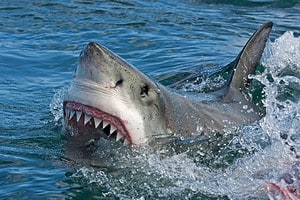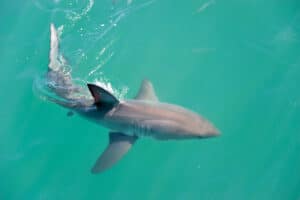Continue reading for our analysis...
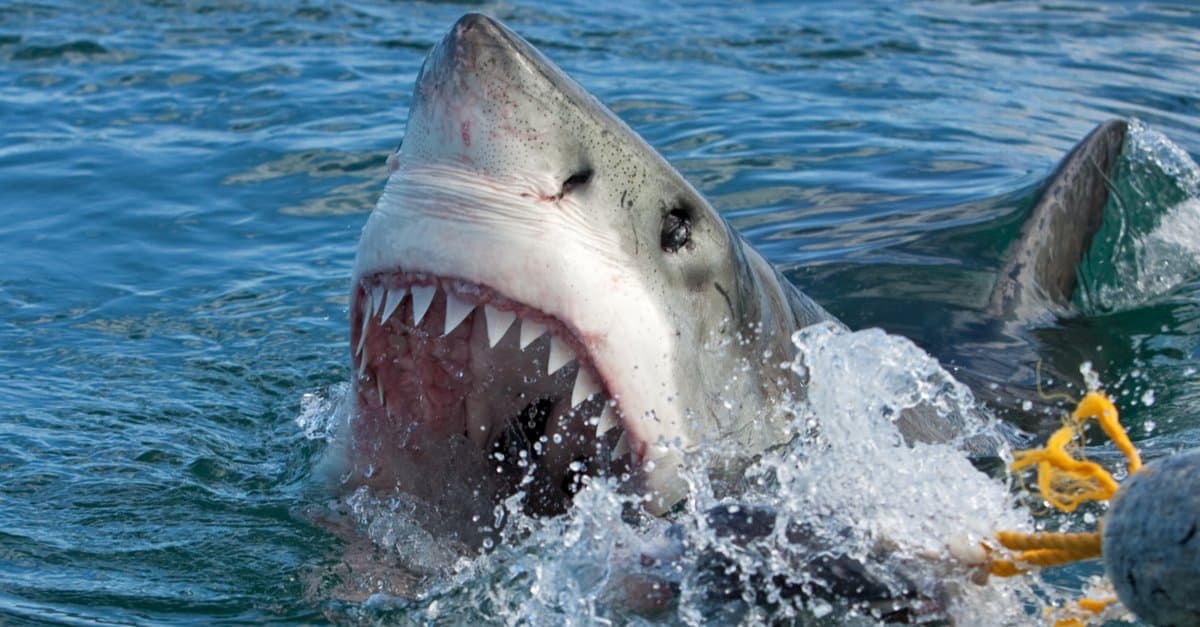
“Come on, shark!”
This amazing video of a shark breaching spectacularly out of the water begins with a man on a boat. He’s waiting for sharks to come after the decoys that he’s trailed so that he can observe and record their breaching behavior. Sharks do this in certain parts of the world and situations to catch their unsuspecting prey by surprise.
Fortunately, this shark did not disappoint.
Jumping out of the water, a Great White Shark lunged after the seal decoy at the end of the line. Because he was so intent on getting his prey, the shark’s entire body moved and wriggled as he leaped out of the water.
“What a breach!” the man yelled.
The shark was 10 feet long. He had powerful muscles and jaws. A male shark, this animal is the apex predator of the seas. When it went after the seal decoy, it had no problem getting its entire body out of the water and making a spectacular splash as it went back to its ocean home.
“In the air, you can see it twisting and turning as if it is trying to dismember its prey,” said the researcher from the boat. And that is likely exactly what the shark had in mind when it went after what it believed was a tasty seal. Scientists tow decoys like these behind small research boats to learn more about sharks’ behavior.
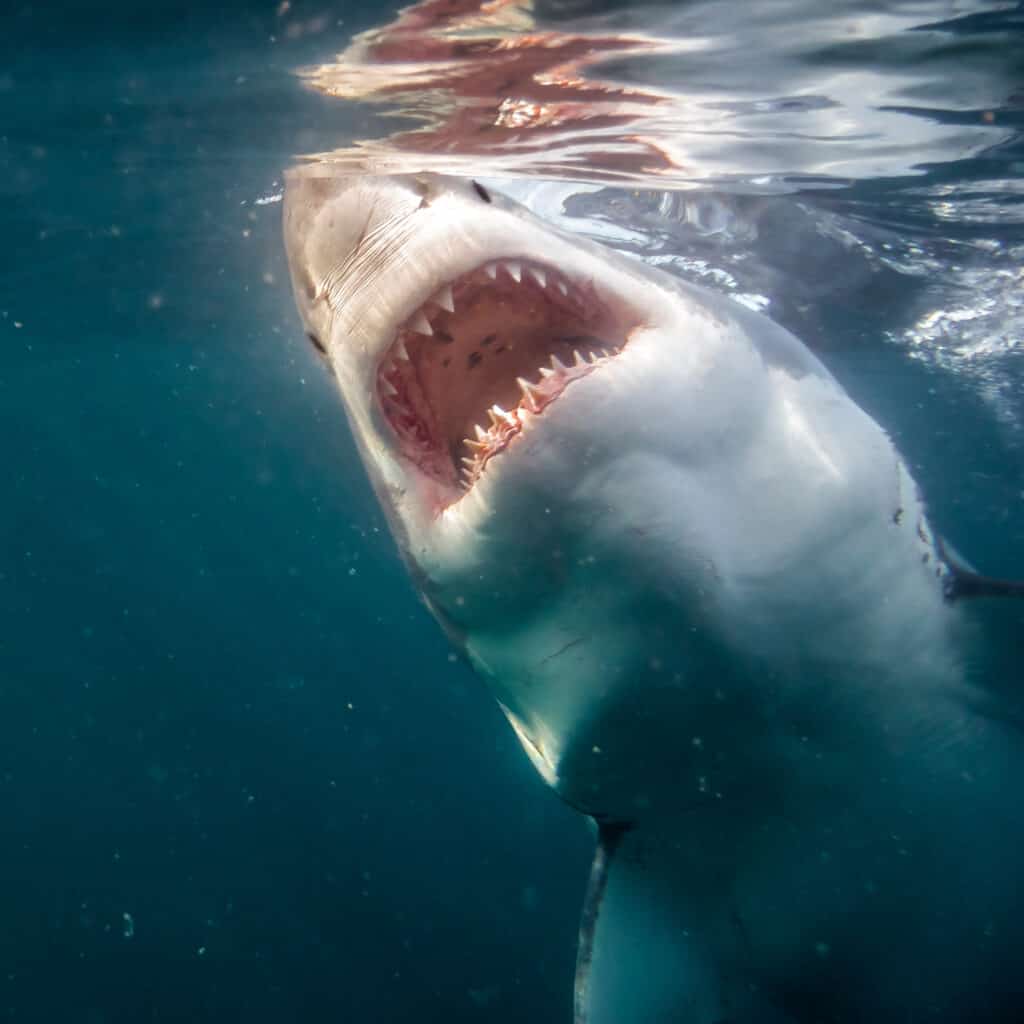
A male shark is the apex predator of the seas.
©Vincent Legrand/Shutterstock.com
This team is located at Seal Rock, just off the coast of Cape Town, South Africa. This is a common place for sharks to breach when they go after seals. Teams of researchers try to get recordings of the most impressive breaches. Chris Fallows, the man in this video, gets a 15-foot jump on video, “the ultimate Air Jaws breach.”
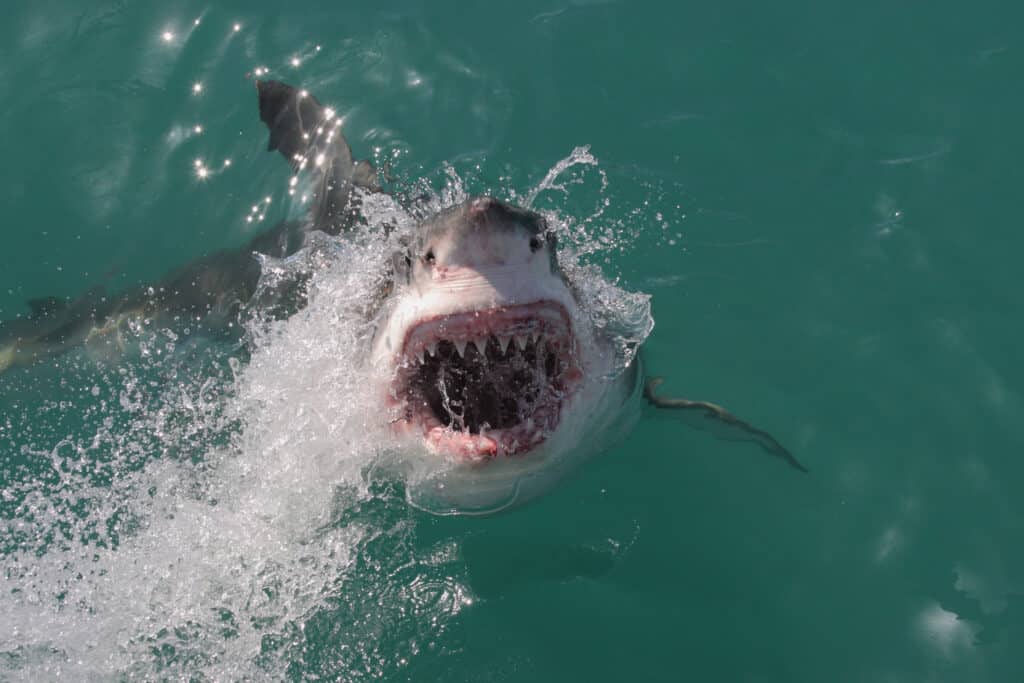
Great White Sharks breach the ocean surface when trying to capture their prey.
©Alessandro De Maddalena/Shutterstock.com
Is This Normal Behavior?
When a great white shark is pursuing a seal or possibly another type of prey, it can swim at speeds up to 40 mph and will typically fly up to 10 feet in the air–an acrobatic feat called breaching. When it hurls itself at a seal, the goal is to hit the animal so hard that it is incapacitated. Studies have suggested that the success rate of this hunting practice for great white sharks is almost 50%. However, it causes the shark to exert a massive amount of energy, so it is not common to witness. Taking the risk may depend on the prey within the crosshairs of the hunting shark. Certain prey may not be worth the energy expenditure.
Ironically, there’s another reason you’d be lucky to see a shark breach. Researchers have found that the one place on earth where breaching is most common is off the coast of South Africa. In False Bay, 45 minutes from Cape Town, there’s an island called Seal Island. This place is home to 64,000 fur seals. Fur seals are prime prey for these sharks because they are just small enough not to cause the shark injury while breaching but are large enough for the shark to grab in its jaws. There’s also a steep drop-off next to the island, so sharks can get close without being detected.
So is breaching normal shark behavior? It is off the coast of South Africa, at least. But a 15-foot leap into the air? That’s a rare sight to see, indeed!
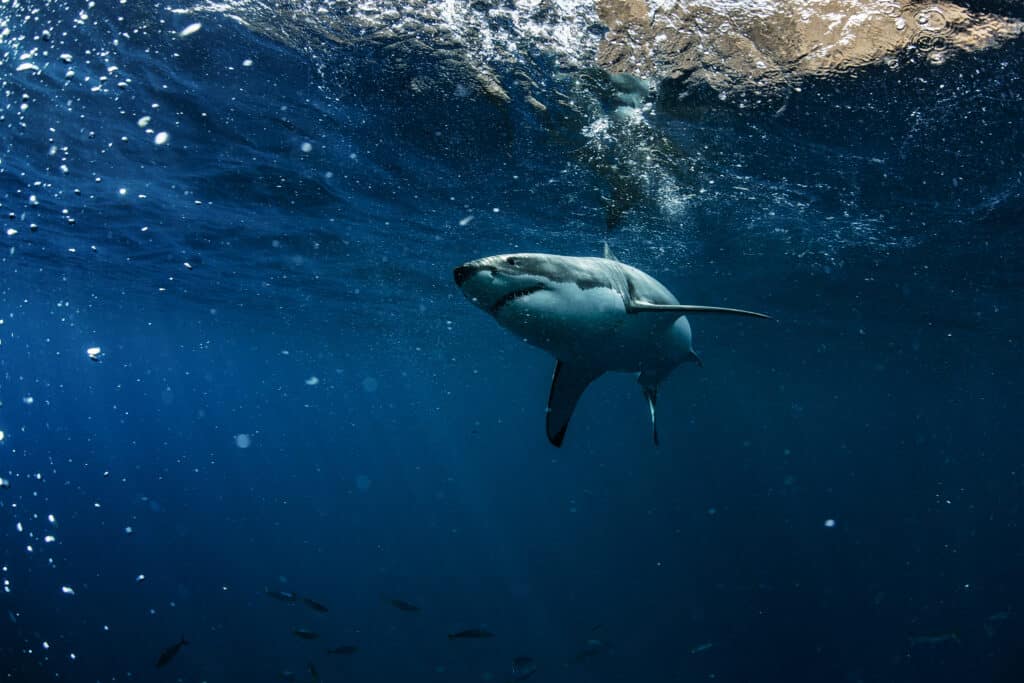
A great white shark can take 20 years to reach full size.
©Willyam Bradberry/Shutterstock.com
Where Do Great White Sharks Live?
Great white sharks can be found in coastal waters around the world. They typically prefer cooler waters, so they are most commonly seen off the coast of California and South Africa, as well as in the Mediterranean Sea. Great white sharks have also been spotted off Australia, Japan, New Zealand, Chile, Mexico, and Hawaii. It is believed that great whites migrate to different oceans seasonally depending on water temperatures and the availability of food sources. However, this has yet to be definitively proven.
Despite their wide range of locations, there are certain areas where great white shark populations appear to be particularly dense such as Seal Island off False Bay near Cape Town in South Africa or Año Nuevo State Park near San Francisco in California. However, due to their elusive nature, it is impossible to know exactly how many may live in these specific areas or across all habitats combined, making them one of the least understood species out there!
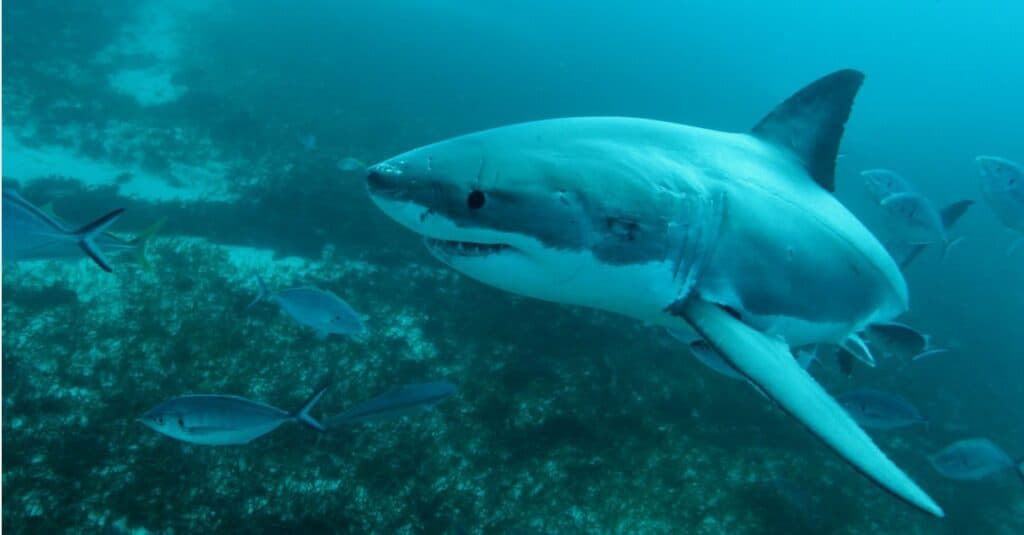
Great white shark pups are big fans of lobster and crab, as well as smaller fish and sharks
©iStock.com/Alessandro De Maddalena
Lifespan, Threats, and Conservation
Great white sharks are estimated to live between 25 and 30 years in the wild. They have a slow growth rate, meaning it could take them up to 20 years before they reach maturity.
The biggest threat facing great white sharks is commercial fishing. Both because they get caught in nets by mistake and because their fins are highly sought after for use in shark fin soup and other products. Overfishing has caused many populations of great whites to become depleted, which can drastically affect the balance of marine ecosystems. Other threats include habitat destruction due to coastal development, pollution from industrial activities, and climate change.
Due to these threats, great white sharks are classified as “vulnerable” by the International Union for Conservation of Nature (IUCN). Therefore, several conservation efforts have been underway since 2003 in an effort to protect this species from further decline. These initiatives focus on creating protected areas where fishing is prohibited or severely limited. Implementing better regulations such as catch limits, public awareness campaigns, and research into population dynamics and movements so that more effective management plans can be developed all need to be put in place.
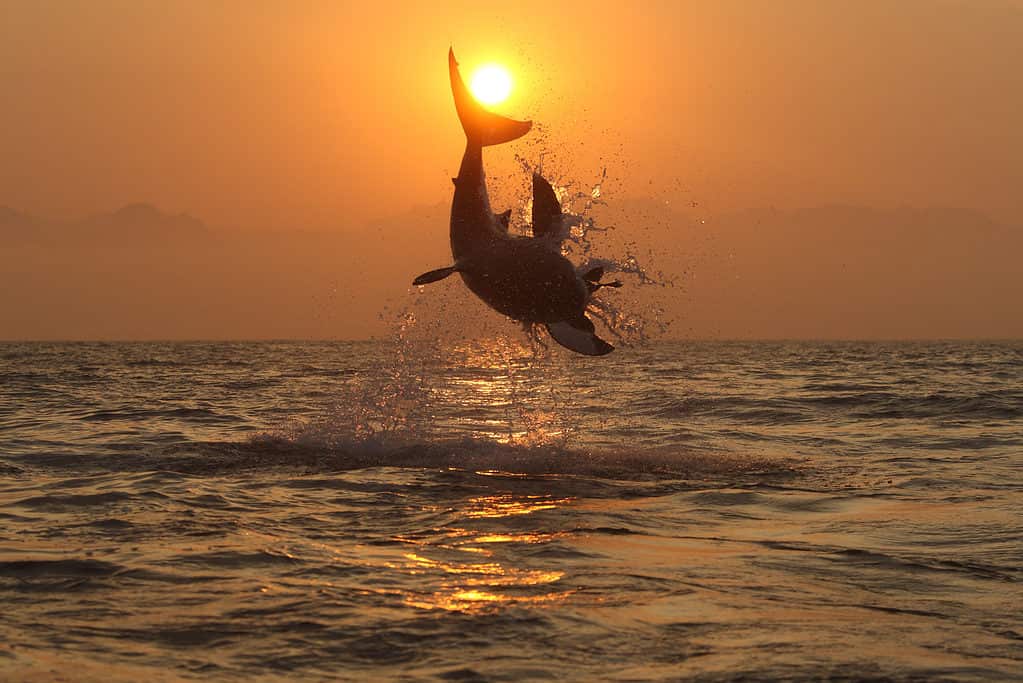
Great White Sharks are vulnerable species due to commercial fishing.
©Alessandro De Maddalena/Shutterstock.com
Great White Shark vs. Bull Shark: What Is The Difference?

Bull sharks typically reach lengths of 11-13 feet while great white sharks can grow up to 20 feet in length.
©Carlos Grillo/Shutterstock.com
The great white shark and the bull shark are both powerful predators, but there are a few differences between them. The most notable difference is size. Great white sharks can grow up to 20 feet in length, while bull sharks typically reach lengths of 11-13 feet.
Another key difference is their habitat preferences. Great whites tend to inhabit coastal waters around the world, while bull sharks prefer shallow tropical and subtropical seas such as those found in the Caribbean Sea or the Gulf of Mexico.
Great whites have eyes that face forward for better vision when pursuing prey, whereas bull sharks’ eyes are located on either side of their head for an increased range of peripheral vision when navigating murky water.
Finally, due to their different dietary habits, with great whites mostly eating fish and marine mammals like seals and sea lions versus bulls who feed on smaller fish and invertebrates, they rarely compete directly against each other for food sources.
Thank you for reading! Have some feedback for us? Contact the AZ Animals editorial team.



